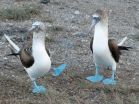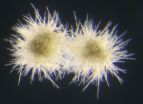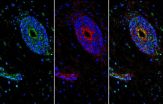Birds show surprising resilience in the face of natural stresses
2015-04-22
(Press-News.org) Life as a wild baby bird can involve a lot of stress; competing with your siblings, dealing with extreme weather, and going hungry due to habitat loss are just a few examples. However, birds have an amazing capacity to overcome stresses experienced early in life and go on to reproductive success as adults, according to a new Perspective paper in The Auk: Ornithological Advances by Hugh Drummond and Sergio Ancona of the Universidad Nacional Autónoma de México.
Some experiments with birds in captivity have found that increasing early-life stress through food deprivation, elevated stress hormones, and other means has negative effects once birds reach adulthood, causing them to live shorter lives and produce fewer offspring. However, Drummond and Ancona argue that the artificial stresses created in these experiments go well beyond what would ever be experienced by wild birds and therefore don't reflect what happens in nature. Reviewing the available studies describing how wild birds fare as adults after experiencing stress in the nest, they give several examples of birds' ability to compensate for their early disadvantages, making adjustments such as beginning to breed earlier in life.
Drummond's interest in bird resilience arose from his research on Blue-footed Boobies. "There were dozens of published studies, mostly experimental, appearing to show that setbacks early in infancy left birds scarred in some way for the rest of their lives," he explained. "But when we analyzed our own observations on Blue-footed Boobies, following individuals banded at fledging over their lifetimes, what stood out was their resilience to severe stresses in infancy. For example, boobies that grew up suffering daily oppression by their elder siblings performed just as well as those siblings on a whole suite of measures taken during adulthood, including annual survival at all ages, age of first breeding, aggressive defense of offspring, and reproductive success at all ages."
"The authors have helped reorient researchers to a vastly understudied area--the evolutionary interplay between early life conditions and phenotypic plasticity," adds Daniel Ardia, an expert in life history tradeoffs in birds from Franklin & Marshall College who was not involved with the paper. "While laboratory experiments are essential to understand genetic and physiological mechanisms, it is only in field conditions that we will gain insight into the flexibility of development in the face of changing environmental conditions. This Perspective helps chart the way forward for field and laboratory researchers alike."
INFORMATION:
About the journal: The Auk: Ornithological Advances is a peer-reviewed, international journal of ornithology. The journal has been the official publication of the American Ornithologists' Union since 1884. In 2009, The Auk was honored as one of the 100 most influential journals of biology and medicine over the past 100 years, and currently holds the top impact factor among ornithological journals.
[Attachments] See images for this press release:

ELSE PRESS RELEASES FROM THIS DATE:
2015-04-22
TEMPE, Ariz. - As the search continues for Earth-size planets orbiting at just the right distance from their star, a region termed the habitable zone, the number of potentially life-supporting planets grows. In two decades we have progressed from having no extrasolar planets to having too many to search. Narrowing the list of hopefuls requires looking at extrasolar planets in a new way. Applying a nuanced approach that couples astronomy and geophysics, Arizona State University researchers report that from that long list we can cross off cosmic neighbor Tau Ceti.
The ...
2015-04-22
Scientists have found something they can't quite explain in one of the most barren environments on Earth: a bacterium whose DNA sequence contains elements usually only found in a much higher organism.
Trichodesmium is a type of bacteria known as an oligotroph, meaning that it can survive in incredibly nutrient-poor regions of the ocean. In fact, it thrives there -- to the point that great blooms of the microorganism can be seen both with the naked eye and from satellites in space, earning it the name "sea sawdust" from ancient mariners.
This is because Trichodesmium ...
2015-04-22
A new type of graphene aerogel will make for better energy storage, sensors, nanoelectronics, catalysis and separations.
Lawrence Livermore National Laboratory researchers have made graphene aerogel microlattices with an engineered architecture via a 3D printing technique known as direct ink writing. The research appears in the April 22 edition of the journal, Nature Communications.
The 3D printed graphene aerogels have high surface area, excellent electrical conductivity, are lightweight, have mechanical stiffness and exhibit supercompressibility (up to 90 percent ...
2015-04-22
Montréal, April 22, 2015 - Researchers at the IRCM led by Artur Kania, PhD, uncovered the critical role in pain processing of a gene associated with a rare disease. Their breakthrough, published in The Journal of Neuroscience, paves the way for a better understanding of chronic pain conditions.
Dr. Kania's team studies the way neural circuits transform harmful stimuli (such as cold, heat, and pinch) into the perception of pain. More precisely, they examined the gene Lmx1b and its involvement in pain processing. Mutations in this gene also cause a rare human disease ...
2015-04-22
PHILADELPHIA - In the first major study to examine the use of a computer-assisted, photo-driven differential diagnosis generator for skin conditions, researchers at the Perelman School of Medicine at the University of Pennsylvania found physicians routinely used the tool, without an increase in calling for inpatient dermatology consultations. The software diagnostic tool, VisualDx, aids in diagnosing dermatologic conditions by allowing physicians to enter information such as the type and location of a rash, and associated symptoms such as pain or itching, and then generating ...
2015-04-22
SAN FRANCISCO--It may seem unlikely that a large earthquake would take place hundreds of kilometers away from a tectonic plate boundary, in areas with low levels of strain on the crust from tectonic motion. But major earthquakes such as the Mw 7.9 2008 Chengdu quake in China and New Zealand's 2011 Mw 6.3 quake have shown that large earthquakes do occur and can cause significant infrastructure damage and loss of life. So what should seismologists look for if they want to identify where an earthquake might happen despite the absence of historical seismic activity?
Roger ...
2015-04-22
COLUMBUS, Ohio - Researchers have uncovered the first evidence of a genetic link between prodigy and autism.
The scientists found that child prodigies in their sample share some of the same genetic variations with people who have autism.
These shared genetic markers occur on chromosome 1, according to the researchers from The Ohio State University and Nationwide Children's Hospital in Columbus.
The findings confirm a hypothesis made by Joanne Ruthsatz, co-author of the study and assistant professor of psychology at Ohio State's Mansfield campus.
In a previous study, ...
2015-04-22
WASHINGTON - Vehicle cost, current battery technology, and inadequate consumer knowledge are some of the barriers preventing widespread adoption of plug-in electric vehicles, says a new congressionally mandated report from the National Research Council. Developing less expensive, better performing batteries is essential to reducing overall vehicle cost, and a market strategy is needed to create awareness and overcome customer uncertainty. The report recommends a range of incentives that the federal government can offer to address these and other barriers.
The report ...
2015-04-22
The brain is a privileged organ in the body. So vital to life, the brain is protected from alterations elsewhere in the body by a highly regulated gateway known as the blood-brain barrier, which allows only selected molecules to pass through.
In certain diseases, however, such as multiple sclerosis, the barrier can be improperly breached. These "leaks" can allow immune cells and inflammatory molecules to pass through, causing inflammation that leads to neuronal damage.
In a new study, researchers have made insights into how the blood-brain barrier, or BBB, is maintained, ...
2015-04-22
The widespread use of cloth masks by healthcare workers may actually put them at increased risk of respiratory illness and viral infections and their global use should be discouraged, according to a UNSW study.
The results of the first randomised clinical trial (RCT) to study the efficacy of cloth masks were published today in the journal BMJ Open.
The trial saw 1607 hospital healthcare workers across 14 hospitals in the Vietnamese capital, Hanoi, split into three groups: those wearing medical masks, those wearing cloth masks and a control group based on usual practice, ...
LAST 30 PRESS RELEASES:
[Press-News.org] Birds show surprising resilience in the face of natural stresses



